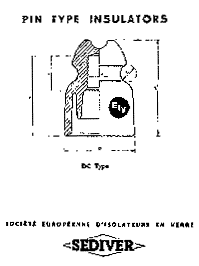The E. I. V. French Insulator
by Ira G. Groff
Reprinted from "INSULATORS - Crown Jewels of the Wire",, October 1970, page 8
One of the largest glass factories in Europe is the Saint-Gobain works at Saint-Yorre, France. Manufacturing everything from insulators to giant telescope mirrors, they have a reputation for quality glassware.
I was lucky enough, on a recent trip to Europe, to obtain some insulators made by their subsidiary, Sediver, which, as you can see from the illustration, stands for European Society for Glass
Insulators (Societe Europeenne D'isolateurs en Verre).
The E.I.V.s were made in three series, the DC 2, DC 3, and DC 4. Only the DC 2 is manufactured at present, making the DC 3 and DC 4 extremely rare insulators for the
American collector.
Another variation in the DC series is the presence or absence of threads, the ones I have being threadless but with corrugations inside the thread holes for the purpose of gripping cement.
The raised ridges that engulf the cable are another characteristic of French insulators. They are apparent on the photo of the large Power insulator submitted by Mr. Chris
Buys in "INSULATORS - Crown Jewels of the Wire", June 1970, page 17 I assume this was also made by Sediver.
The glass is very fine, aqua-colored crystal and contains no bubbles or cold shuts. There are no drip points, but the bottom of the skirt is milled like a coin edge.
The dimensions are as follows:
Type H
D d
weight
DC 2 4"
3" 7/8"
1 lb.
DC 3 4-1/2" 3-3/8"
15/16" 1-2/5 1bs.
DC 4 5-15/16" 4"
15/16" 1-4/5 1bs.

The illustration bears a vague resemblance to Mr. Woodward's CD 222 (a CD
pictured in early Brookfield catalog), but a look at the insulator itself immediately betrays its foreign origin.
I hope this article has helped collectors in their identification of foreign insulators, and
I plan to have some information on insulators from other countries in the near future.
|
